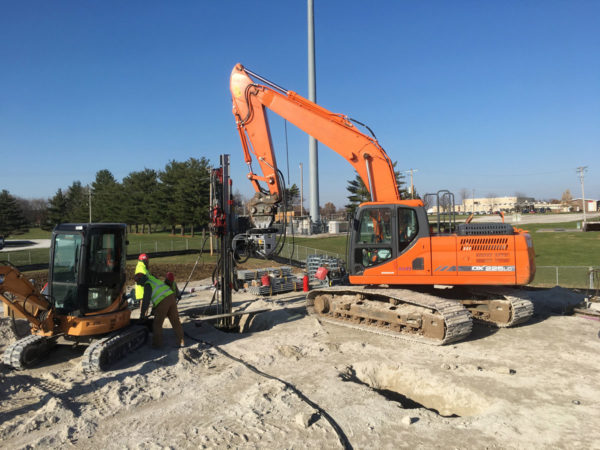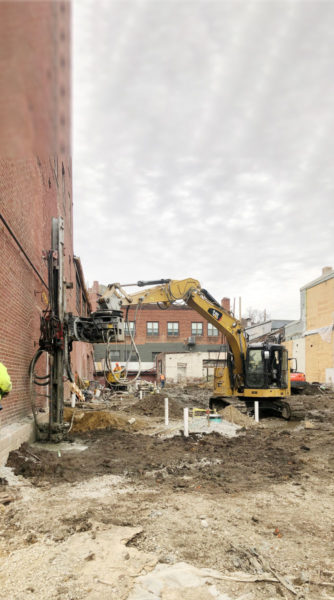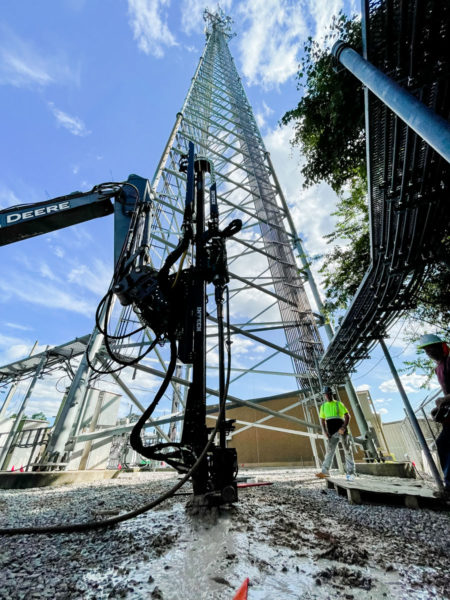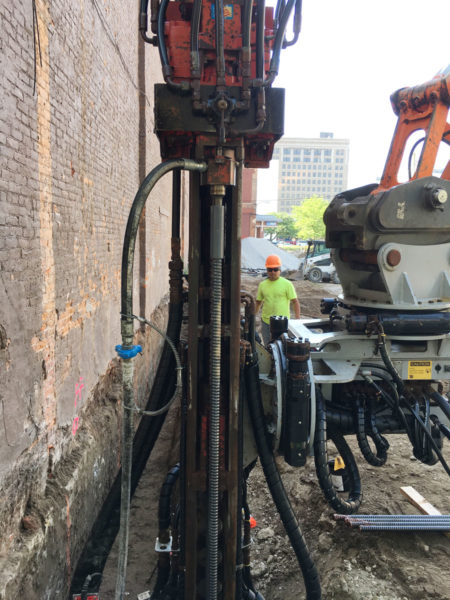Hollow bar micropiles are a type of micropile with a hollow core and a disposable drill bit on the end designed to consolidate the number of installation steps when compared to other micropiling methods.
 The drill bit is selected to core through the specific soil type at the site (e.g., clay, sand, gravel, rock) at the required pile diameter.
As the drill digs to the specified depth, a threaded hollow bar follows, acting as a conduit for cement grout to pass through as it’s ejected from the end of the drill bit. Once the drill reaches the required depth, micropile drilling, flushing, grouting, and installation have already been completed, significantly reducing the number of steps required to achieve a reliable anchor point.
The drill bit is selected to core through the specific soil type at the site (e.g., clay, sand, gravel, rock) at the required pile diameter.
As the drill digs to the specified depth, a threaded hollow bar follows, acting as a conduit for cement grout to pass through as it’s ejected from the end of the drill bit. Once the drill reaches the required depth, micropile drilling, flushing, grouting, and installation have already been completed, significantly reducing the number of steps required to achieve a reliable anchor point.  Because drilling, grouting, and installation happen simultaneously, hollow bar micropiling requires no pre-drilling or pre-/post-grouting, not only reducing the number of steps but also the amount of equipment needed for installation. A rock drill and grout plant are generally all that’s required for hollow bar micropiling. Even with less equipment, however, it’s still possible to maximize micropile strength by increasing grout pressure to enlarge pile diameter. For example, a drill bit with a 2.5-inch diameter can produce a group column of up to eight inches.
After acting as both the drill rod and a conduit for grout, the hollow bar then remains in place as a steel reinforcement bar following installation. The type of steel or protective casing used for the hollow bar is optimized for site soil conditions to prevent corrosion over time and ensure a long-lasting anchor pile. Hollow bars also offer superior increased bending capacity, readily absorbing lateral, compression, and tension forces as soil shifts.
Because drilling, grouting, and installation happen simultaneously, hollow bar micropiling requires no pre-drilling or pre-/post-grouting, not only reducing the number of steps but also the amount of equipment needed for installation. A rock drill and grout plant are generally all that’s required for hollow bar micropiling. Even with less equipment, however, it’s still possible to maximize micropile strength by increasing grout pressure to enlarge pile diameter. For example, a drill bit with a 2.5-inch diameter can produce a group column of up to eight inches.
After acting as both the drill rod and a conduit for grout, the hollow bar then remains in place as a steel reinforcement bar following installation. The type of steel or protective casing used for the hollow bar is optimized for site soil conditions to prevent corrosion over time and ensure a long-lasting anchor pile. Hollow bars also offer superior increased bending capacity, readily absorbing lateral, compression, and tension forces as soil shifts.  Solid bar micropiling is a conventional approach to anchoring deep pile foundation systems. However, they are limited in application and require additional steps before and after installation. Solid bar micropiles can only be installed in areas with shallow rock foundations, and specialized casings are required for softer soils.
Installation is more involved because pre-drilling, pre-grouting, and post-grouting are required, increasing project time, cost, and the amount of equipment needed. Prior to solid bar installation, a hole first has to be drilled and grouted. Grouting is again required after the bar is installed. As a result, solid bar micropiling is better suited to new construction foundation improvement but often isn’t feasible for existing buildings.
Solid bar micropiling is a conventional approach to anchoring deep pile foundation systems. However, they are limited in application and require additional steps before and after installation. Solid bar micropiles can only be installed in areas with shallow rock foundations, and specialized casings are required for softer soils.
Installation is more involved because pre-drilling, pre-grouting, and post-grouting are required, increasing project time, cost, and the amount of equipment needed. Prior to solid bar installation, a hole first has to be drilled and grouted. Grouting is again required after the bar is installed. As a result, solid bar micropiling is better suited to new construction foundation improvement but often isn’t feasible for existing buildings.  Hollow bar micropiling developed after solid bar micropiling, improving the conventional process by eliminating the need for pre-drilling since drilling occurs concurrently with hollow bar installation. Grouting is also part of the installation process, so the need for pre- and post-grouting are eliminated. Hollow bar micropiles are also more versatile than solid bar micropiles. They can be optimized to provide a reliable pile for virtually any soil type with a wider range of pile diameter and depth options.
Along with soil conditions, one of the most important considerations when deciding between solid bar and hollow bar micropiling is the amount of working space at the site. Since solid bar micropiles require more installation equipment, it can be difficult or impossible to anchor them in areas with limited space. Hollow bar micropile installation, on the other hand, involves less equipment, and it’s much easier to coordinate in tight work areas, even with limited overhead and lateral movement. Because of this, hollow bar micropiling is suitable for new construction foundation improvement and for existing structures.
Hollow bar micropiling developed after solid bar micropiling, improving the conventional process by eliminating the need for pre-drilling since drilling occurs concurrently with hollow bar installation. Grouting is also part of the installation process, so the need for pre- and post-grouting are eliminated. Hollow bar micropiles are also more versatile than solid bar micropiles. They can be optimized to provide a reliable pile for virtually any soil type with a wider range of pile diameter and depth options.
Along with soil conditions, one of the most important considerations when deciding between solid bar and hollow bar micropiling is the amount of working space at the site. Since solid bar micropiles require more installation equipment, it can be difficult or impossible to anchor them in areas with limited space. Hollow bar micropile installation, on the other hand, involves less equipment, and it’s much easier to coordinate in tight work areas, even with limited overhead and lateral movement. Because of this, hollow bar micropiling is suitable for new construction foundation improvement and for existing structures. For more than 20 years, Intech Anchoring Systems has supplied commercial, residential, and industrial contractors with advanced deep foundation solutions, including products and services, such as hollow bar micropiling. If you need to understand which deep pile foundation options are right for your next deep foundations project, the experts at Intech Anchoring Systems can help you get started. Whether you need help with new construction foundation improvements or deep foundations for existing structures, we arrive ready with the capabilities and experience to oversee every step from a preliminary project meeting to project completion.

Tim is the President of Intech Anchoring and has 25 years of experience in the Civil Engineering and Geostructural Industry. Tim has developed extensive industry knowledge by working to support the needs of specialty contractors at each and every business level. Tim’s diverse industry background has given him exposure to a wide variety civil construction projects, ranging from the simplest residential applications to the most complex commercial and industrial projects. Coupled with a highly skilled and educated team, Tim focuses on providing the highest quality products and solutions to Intech Anchoring’s customers in order to consistently exceed expectations.